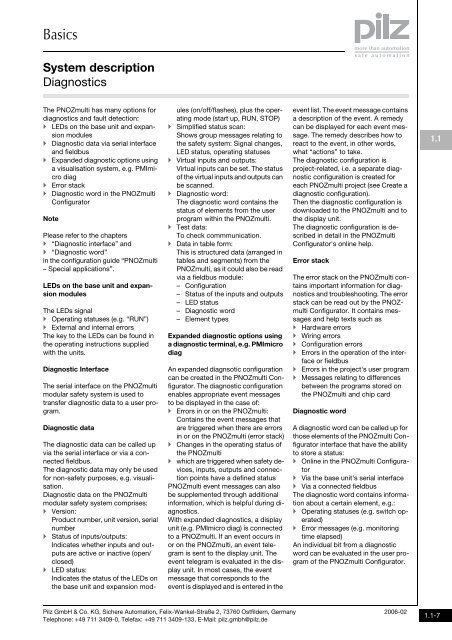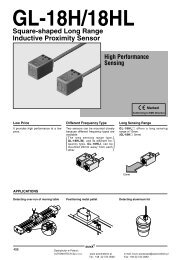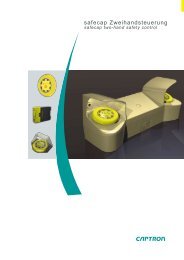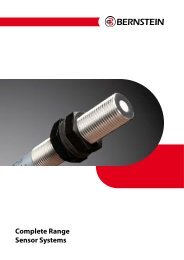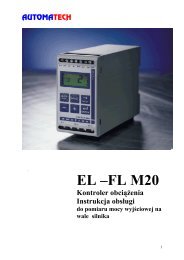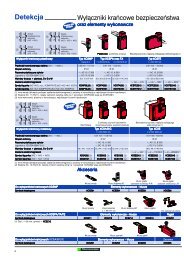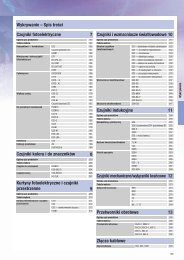Expansion modules - Automatech
Expansion modules - Automatech
Expansion modules - Automatech
You also want an ePaper? Increase the reach of your titles
YUMPU automatically turns print PDFs into web optimized ePapers that Google loves.
Basics<br />
System description<br />
Diagnostics<br />
2006-02<br />
1.1 Basics System Diagnostics description<br />
The PNOZmulti has many options for<br />
diagnostics and fault detection:<br />
LEDs on the base unit and expansion<br />
<strong>modules</strong><br />
Diagnostic data via serial interface<br />
and fieldbus<br />
Expanded diagnostic options using<br />
a visualisation system, e.g. PMImicro<br />
diag<br />
Error stack<br />
Diagnostic word in the PNOZmulti<br />
Configurator<br />
Note<br />
Please refer to the chapters<br />
“Diagnostic interface” and<br />
“Diagnostic word”<br />
in the configuration guide “PNOZmulti<br />
– Special applications”.<br />
LEDs on the base unit and expansion<br />
<strong>modules</strong><br />
The LEDs signal<br />
Operating statuses (e.g. “RUN”)<br />
External and internal errors<br />
The key to the LEDs can be found in<br />
the operating instructions supplied<br />
with the units.<br />
Diagnostic Interface<br />
The serial interface on the PNOZmulti<br />
modular safety system is used to<br />
transfer diagnostic data to a user program.<br />
Diagnostic data<br />
The diagnostic data can be called up<br />
via the serial interface or via a connected<br />
fieldbus.<br />
The diagnostic data may only be used<br />
for non-safety purposes, e.g. visualisation.<br />
Diagnostic data on the PNOZmulti<br />
modular safety system comprises:<br />
Version:<br />
Product number, unit version, serial<br />
number<br />
Status of inputs/outputs:<br />
Indicates whether inputs and outputs<br />
are active or inactive (open/<br />
closed)<br />
LED status:<br />
Indicates the status of the LEDs on<br />
the base unit and expansion <strong>modules</strong><br />
(on/off/flashes), plus the operating<br />
mode (start up, RUN, STOP)<br />
Simplified status scan:<br />
Shows group messages relating to<br />
the safety system: Signal changes,<br />
LED status, operating statuses<br />
Virtual inputs and outputs:<br />
Virtual inputs can be set. The status<br />
of the virtual inputs and outputs can<br />
be scanned.<br />
Diagnostic word:<br />
The diagnostic word contains the<br />
status of elements from the user<br />
program within the PNOZmulti.<br />
Test data:<br />
To check commmunication.<br />
Data in table form:<br />
This is structured data (arranged in<br />
tables and segments) from the<br />
PNOZmulti, as it could also be read<br />
via a fieldbus module:<br />
– Configuration<br />
– Status of the inputs and outputs<br />
– LED status<br />
– Diagnostic word<br />
– Element types<br />
Expanded diagnostic options using<br />
a diagnostic terminal, e.g. PMImicro<br />
diag<br />
An expanded diagnsotic configuration<br />
can be created in the PNOZmulti Configurator.<br />
The diagnostic configuration<br />
enables appropriate event messages<br />
to be displayed in the case of:<br />
Errors in or on the PNOZmulti:<br />
Contains the event messages that<br />
are triggered when there are errors<br />
in or on the PNOZmulti (error stack)<br />
Changes in the operating status of<br />
the PNOZmulti<br />
which are triggered when safety devices,<br />
inputs, outputs and connection<br />
points have a defined status<br />
PNOZmulti event messages can also<br />
be supplemented through additional<br />
information, which is helpful during diagnostics.<br />
With expanded diagnostics, a display<br />
unit (e.g. PMImicro diag) is connected<br />
to a PNOZmulti. If an event occurs in<br />
or on the PNOZmulti, an event telegram<br />
is sent to the display unit. The<br />
event telegram is evaluated in the display<br />
unit. In most cases, the event<br />
message that corresponds to the<br />
event is displayed and is entered in the<br />
event list. The event message contains<br />
a description of the event. A remedy<br />
can be displayed for each event message.<br />
The remedy describes how to<br />
react to the event, in other words,<br />
what “actions” to take.<br />
The diagnostic configuration is<br />
project-related, i.e. a separate diagnostic<br />
configuration is created for<br />
each PNOZmulti project (see Create a<br />
diagnostic configuration).<br />
Then the diagnostic configuration is<br />
downloaded to the PNOZmulti and to<br />
the display unit.<br />
The diagnostic configuration is described<br />
in detail in the PNOZmulti<br />
Configurator's online help.<br />
Error stack<br />
The error stack on the PNOZmulti contains<br />
important information for diagnostics<br />
and troubleshooting. The error<br />
stack can be read out by the PNOZmulti<br />
Configurator. It contains messages<br />
and help texts such as<br />
Hardware errors<br />
Wiring errors<br />
Configuration errors<br />
Errors in the operation of the interface<br />
or fieldbus<br />
Errors in the project's user program<br />
Messages relating to differences<br />
between the programs stored on<br />
the PNOZmulti and chip card<br />
Diagnostic word<br />
A diagnostic word can be called up for<br />
those elements of the PNOZmulti Configurator<br />
interface that have the ability<br />
to store a status:<br />
Online in the PNOZmulti Configurator<br />
Via the base unit's serial interface<br />
Via a connected fieldbus<br />
The diagnostic word contains information<br />
about a certain element, e.g.:<br />
Operating statuses (e.g. switch operated)<br />
Error messages (e.g. monitoring<br />
time elapsed)<br />
An individual bit from a diagnostic<br />
word can be evaluated in the user program<br />
of the PNOZmulti Configurator.<br />
1.1<br />
Pilz GmbH & Co. KG, Sichere Automation, Felix-Wankel-Straße 2, 73760 Ostfildern, Germany<br />
Telephone: +49 711 3409-0, Telefax: +49 711 3409-133, E-Mail: pilz.gmbh@pilz.de<br />
2006-02<br />
1.1-7


